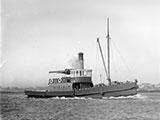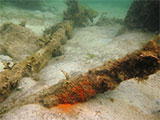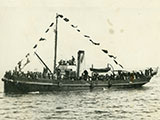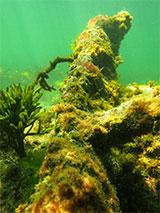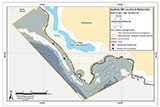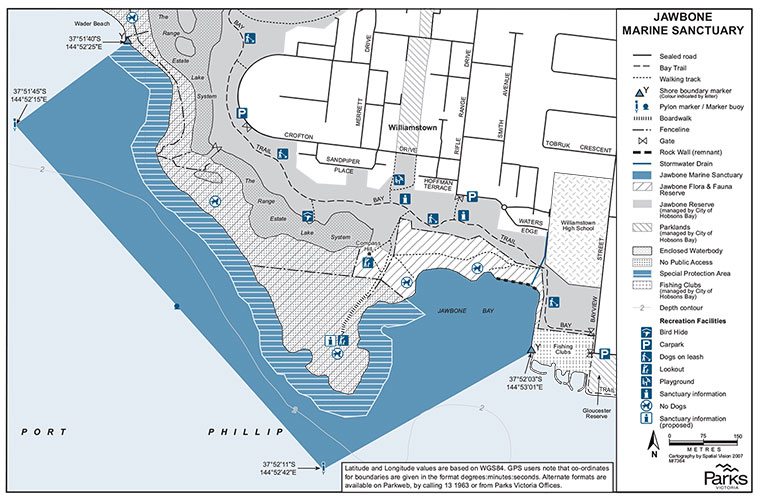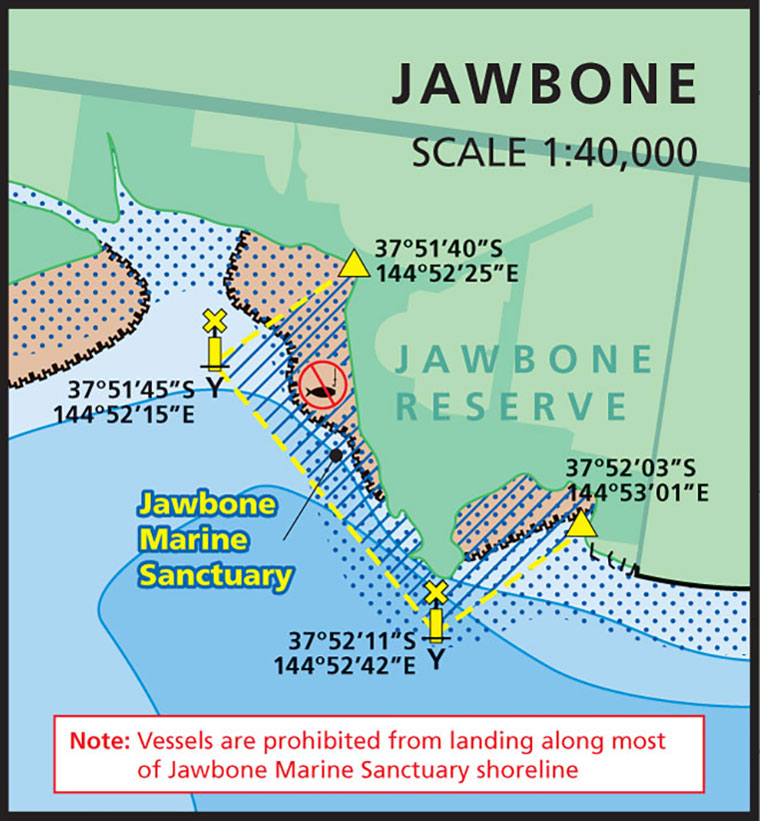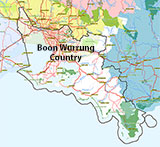Agnes
![]() Wreck Dive |
Wreck Dive | ![]() Boat access
Boat access
![]()
![]()
![]()
![]()
![]()
Wooden Screw Steamer | Max Depth: 5 m (16 ft)
Level: Open Water and beyond.
The remains of a vessel believed to be those of a wooden steamer Agnes were reported to the MAU on the 4 February 1991 by Peter and Colin Taylor from the Maritime Archaeology Association Of Victoria (MAAV). According to the finders, the site lies 50 metres offshore and behind the back of the old Williamstown Rifle Range.
The site appears to be the remains of a large wooden vessel, copper alloy fastened and sheathed. The site is fragmented, cargo appears to have consisted of iron pipe. David Carroll, also of the MAAV believes that the vessel blew ashore in a storm in the early 1950s. This vessel is not mentioned in any of Dr Foster's reports on Williamstown.
Diving and Snorkelling the Agnes Shipwreck
Located in an easily accessible area known as The Jawbone, the Agnes shipwreck site makes for an interesting dive. The wreck is scattered over a large area with various iron knees, some bronze fastenings and about 40 feet of the hull, a winch that is slowly being covered with sand and seagrass.
Agnes Shipwreck History — Built in 1894
The Agnes was built in 1894 by Frederick Moore in Launceston, Tasmania as a wooden screw steamer of 44 l-ton (45 t) for work on the Tamar River between Launceston and George Town. The Agnes had an overall length of approximately 92 ft (28 m), beam 14 ft (4.27 m) and draught 5 ft (1.52 m).
Originally cost about 3,000 pounds. Had been a 'beer boat', carrying beer from Tasmania to Sydney. Sold to Melbourne interests in 1920, used as a Port Phillip tug. The deckhouse was cut away for towing duties. After a number of owners, Agnes had recently been sold again and had engines and boiler removed. Reportedly engaged in the fishing industry or shell grit industry at the time of the wreck.
Agnes Sinking — 14 December 1933
In a severe south-westerly gale, the Agnes was blown from anchorage after mid-day, and drifted on to the reef at the back of the Williamstown rifle range at 5.15 pm on the 14 December 1933. Not insured and was a total loss. No one on board when lost.
See also, MAAV: Agnes 1894-1933,
Heritage Council Victoria: Agnes, and
Australian National Shipwreck Database: Agnes.
Heritage Warning: Any shipwreck or shipwreck relic that is 75 years or older is protected by legislation. Other items of maritime heritage 75 years or older are also protected by legislation. Activities such as digging for bottles, coins or other artefacts that involve the disturbance of archaeological sites may be in breach of the legislation, and penalties may apply. The legislation requires the mandatory reporting to Heritage Victoria as soon as practicable of any archaeological site that is identified. See Maritime heritage. Anyone with information about looting or stolen artefacts should call Heritage Victoria on (03) 7022 6390, or send an email to [email protected].
Jawbone Marine Sanctuary
This site is located within the Jawbone Marine Sanctuary, which is the most northern marine sanctuary in Port Phillip. Jawbone Marine Sanctuary, named after its shape, is located in Williamstown and protects 30ha of coastal waters. The little promontory, west of the beach at Williamstown, has been fenced off from the rest of the world for over 80 years by a coastal rifle range. This unspoiled place is now considered a haven for coastal and marine life right next to Melbourne. It is a great scenic place for children to play too.
The Jawbone Marine Sanctuary begins west of the fishing clubs in Bayview Street, Willamstown, and runs west 1.9 km along the foreshore around the Jawbone to wader beach south of McGuire Crescent. It abuts the Jawbone Flora and Fauna reserve and extends from the high water mark to a maximum of 300 metres offshore.
The sites for diving and snorkelling within the Jawbone Marine Sanctuary are:
- The Jawbone, Williamstown (Melway Map 55 J10)
- The Jawbone West, Williamstown (Melway Map 55 J10)
- Ester
- Carmen
- Agnes
Aboriginal tradition indicates that the sanctuary is part of Country of Boon Wurrung people.
More protected than many sites in the area, so a good site to dive instead when the wind is up a bit. There are many spots to dive here in all directions.
Jawbone Wrecks
The sanctuary was used as a scuttling ground for ships that had outlived their usefulness. The exposed location, rocky bottom, proximity to Williamstown and restricted public access made it an ideal place to scuttle wrecks.
Along the west edge of Jawbone are the remnants of some shipwrecks including: Agnes, Carmen, Ester, Macedon, and Salsette. The Kakariki, Orange Grove, and Baldrock also lie nearby, plus there are other unidentified wrecks.
Also not far from Jawbone are the remains of a Vultee Vengeance Aircraft.
See also Park Note: Jawbone Marine Sanctuary,
Parks Victoria: Jawbone Marine Sanctuary,
Jawbone Marine Sanctuary Care Group,
Taxonomic Toolkit for the Marine Life of Port Phillip Bay, and
How To Assess Visibility Before Heading To Snorkel Sites In Port Phillip / Western Port — by Simon Mustoe, 20 January 2022.
You are not permitted to carry a spear gun while snorkelling or scuba diving in Jawbone Marine Sanctuary.
Traditional Owners — This dive site is in the traditional Country of the Boon Wurrung / Bunurong people of the Kulin Nation. This truly ancient Country includes parts of Port Phillip, from the Werribee River in the north-west, down to Wilson's Promontory in the south-east, including the Mornington Peninsula, French Island and Phillip Island, plus Western Port. We wish to acknowledge the Boon Wurrung as Traditional Owners. We pay respect to their Ancestors and their Elders, past, present and emerging. We acknowledge Bunjil the Creator Spirit of this beautiful land, who travels as an eagle, and Waarn, who protects the waterways and travels as a crow, and thank them for continuing to watch over this Country today and beyond.
Agnes Location Map
Latitude: 37° 51.823′ S (37.863717° S / 37° 51′ 49.38″ S)
Longitude: 144° 52.344′ E (144.8724° E / 144° 52′ 20.64″ E)
Datum: WGS84 |
Google Map
Added: 2021-02-07 08:48:30 GMT, Last updated: 2022-05-01 21:53:07 GMT
Source: Google Earth
Nearest Neighbour: Carmen, 427 m, bearing 137°, SE
Wooden Screw Steamer.
Built: Launceston, Tasmania, 1894.
Sunk: 14 December 1933.
Jawbone Marine Sanctuary, Port Phillip.
Depth: 5 m.
[ Top ]
DISCLAIMER: No claim is made by The Scuba Doctor as to the accuracy of the dive site coordinates listed here. Should anyone decide to use these GPS marks to locate and dive on a site, they do so entirely at their own risk. Always verify against other sources.
The marks come from numerous sources including commercial operators, independent dive clubs, reference works, and active divers. Some are known to be accurate, while others may not be. Some GPS marks may even have come from maps using the AGD66 datum, and thus may need be converted to the WGS84 datum. To distinguish between the possible accuracy of the dive site marks, we've tried to give each mark a source of GPS, Google Earth, or unknown.

